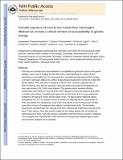Prenatal exposure of mice to the human liver carcinogen aflatoxin B
Author(s)
Thiantanawat, Apinya; Egner, Patricia A.; Groopman, John D.; Chawanthayatham, Supawadee; Wogan, Gerald N; Croy, Robert G; Essigmann, John M; ... Show more Show less
DownloadPrenatal exposure.pdf (725.5Kb)
OPEN_ACCESS_POLICY
Open Access Policy
Creative Commons Attribution-Noncommercial-Share Alike
Terms of use
Metadata
Show full item recordAbstract
It has become axiomatic that critical windows of susceptibility to genotoxins exist and that genetic damage in utero may be a trigger for later life cancers. Data supporting this critical window hypothesis are remarkably few. This study provides a quantitative bridge between DNA damage by the liver carcinogen aflatoxin B[subscript 1] (AFB[subscript 1]) during prenatal development and the risk of later life genetic disease. AFB[subscript 1] was given to pregnant C57BL/6J mice, carrying F[subscript 1] gestation day 14 (GD14) embryos of the B6C3F1 genotype. Ultra-high performance liquid chromatography and mass spectrometry (UPLC-MS) using aflatoxin-[superscript 15]N[subscript 5]-guanine adduct standards afforded measurement of the AFB[subscript 1]-N[superscript 7]-Gua and AFB[subscript 1]-FAPY adducts 6-hr post dosing in liver DNA of mothers and embryos. A parallel cohort gave birth and the livers of the F[subscript 1] were analyzed for mutations in the gpt gene at 3 and 10 weeks of age. The data revealed mutational spectra dominated by G:C to T:A mutations in both the mother and offspring that are characteristic of AFB[subscript 1] and distinct from background. It was shown that adducts in GD14 embryos were 20-fold more potent inducers of mutagenesis than adducts in parallel-dosed adults. This sensitivity enhancement correlated with Ki67 staining of the liver, reflecting the proliferative potential of the tissue. Taken together, these data provide insight into the relative genetic risks of prenatal and adult exposures to AFB[subscript 1]. Early life exposure, especially during the embryonic period, is strikingly more mutagenic than treatment later in life. Moreover the data provide a baseline against which risk prevention strategies can be evaluated.
Date issued
2014-08Department
Massachusetts Institute of Technology. Department of Biological Engineering; Massachusetts Institute of Technology. Department of ChemistryJournal
International Journal of Cancer
Publisher
Wiley Blackwell
Citation
Chawanthayatham, Supawadee et al. “Prenatal Exposure of Mice to the Human Liver Carcinogen Aflatoxin B 1 Reveals a Critical Window of Susceptibility to Genetic Change: Genetic Effects of Aflatoxin B 1.” International Journal of Cancer 136.6 (2015): 1254–1262.
Version: Author's final manuscript
ISSN
0020-7136
1811-9735